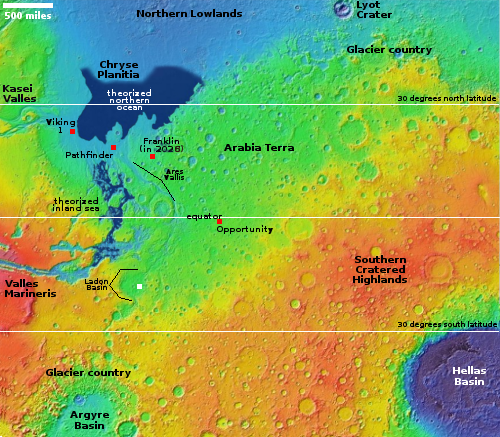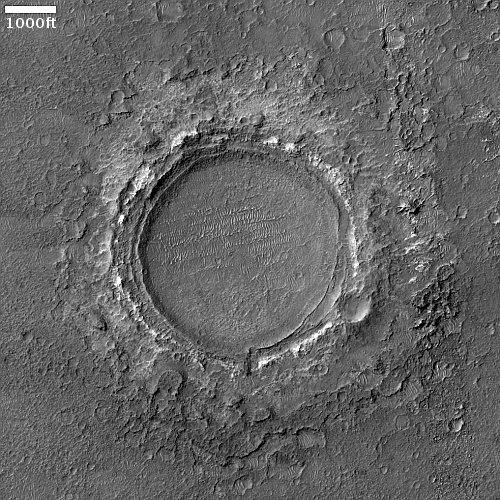Puzzling crater on alien Mars
Today’s cool image once again illustrates that the things that orbiters photograph on the Martian surface are not always what they seem at first glance. The picture to the right, cropped, reduced, and sharpened to post here, was taken on March 23, 2023 by the high resolution camera on Mars Reconnaissance Orbiter (MRO). It shows what the scientists label as “layering” in this small mile-wide crater.
That layering, seen on both the interior and exterior slopes of its circular rim, is what makes this crater puzzling. It suggests this crater was not formed by an impact, but by volcanism. The layers suggest repeated eruptive events. That the crater sits above the surround plain by about 100 feet strengthens this conclusion.
And yet, a look at the overview map below suggests this conclusion is premature.

The white dot inside the large 250-wide Ladon Basin marks this crater’s location. Ladon appears to be a very ancient very eroded impact crater, barely visible any longer, with a very distinct canyon, Ladon Valles, entering it from the south, and a second canyon, Morava Valles, exiting it from the north and eventually linking to Ares Vallis to drain into the northern lowland plains of Chryse Planitia.
Many of the craters in Ladon Basin appear to sit above the surrounding terrain. This suggests their impact occurred a long time ago, compressing the material in the crater so it was resistant to the erosion that subsequently removed the ground around it. Research has suggested that there was water and ice at one time in this basin, though not enough to form a lake, but certainly enough to cause that erosion.
The layers however once again make the impact interpretation difficult. An impact doesn’t leave behind such neat layers, unless those layers were placed down after the impact, covering the crater, and then removed by erosion. The problem with this is that the layers seem so integral to the crater’s structure. Could they be a sign of layers that existed before the impact?
Theories and theories and theories. It is all guessing without more information.
On Christmas Eve 1968 three Americans became the first humans to visit another world. What they did to celebrate was unexpected and profound, and will be remembered throughout all human history. Genesis: the Story of Apollo 8, Robert Zimmerman's classic history of humanity's first journey to another world, tells that story, and it is now available as both an ebook and an audiobook, both with a foreword by Valerie Anders and a new introduction by Robert Zimmerman.
The print edition can be purchased at Amazon or from any other book seller. If you want an autographed copy the price is $60 for the hardback and $45 for the paperback, plus $8 shipping for each. Go here for purchasing details. The ebook is available everywhere for $5.99 (before discount) at amazon, or direct from my ebook publisher, ebookit. If you buy it from ebookit you don't support the big tech companies and the author gets a bigger cut much sooner.
The audiobook is also available at all these vendors, and is also free with a 30-day trial membership to Audible.
"Not simply about one mission, [Genesis] is also the history of America's quest for the moon... Zimmerman has done a masterful job of tying disparate events together into a solid account of one of America's greatest human triumphs."--San Antonio Express-News
Today’s cool image once again illustrates that the things that orbiters photograph on the Martian surface are not always what they seem at first glance. The picture to the right, cropped, reduced, and sharpened to post here, was taken on March 23, 2023 by the high resolution camera on Mars Reconnaissance Orbiter (MRO). It shows what the scientists label as “layering” in this small mile-wide crater.
That layering, seen on both the interior and exterior slopes of its circular rim, is what makes this crater puzzling. It suggests this crater was not formed by an impact, but by volcanism. The layers suggest repeated eruptive events. That the crater sits above the surround plain by about 100 feet strengthens this conclusion.
And yet, a look at the overview map below suggests this conclusion is premature.

The white dot inside the large 250-wide Ladon Basin marks this crater’s location. Ladon appears to be a very ancient very eroded impact crater, barely visible any longer, with a very distinct canyon, Ladon Valles, entering it from the south, and a second canyon, Morava Valles, exiting it from the north and eventually linking to Ares Vallis to drain into the northern lowland plains of Chryse Planitia.
Many of the craters in Ladon Basin appear to sit above the surrounding terrain. This suggests their impact occurred a long time ago, compressing the material in the crater so it was resistant to the erosion that subsequently removed the ground around it. Research has suggested that there was water and ice at one time in this basin, though not enough to form a lake, but certainly enough to cause that erosion.
The layers however once again make the impact interpretation difficult. An impact doesn’t leave behind such neat layers, unless those layers were placed down after the impact, covering the crater, and then removed by erosion. The problem with this is that the layers seem so integral to the crater’s structure. Could they be a sign of layers that existed before the impact?
Theories and theories and theories. It is all guessing without more information.
On Christmas Eve 1968 three Americans became the first humans to visit another world. What they did to celebrate was unexpected and profound, and will be remembered throughout all human history. Genesis: the Story of Apollo 8, Robert Zimmerman's classic history of humanity's first journey to another world, tells that story, and it is now available as both an ebook and an audiobook, both with a foreword by Valerie Anders and a new introduction by Robert Zimmerman.
The print edition can be purchased at Amazon or from any other book seller. If you want an autographed copy the price is $60 for the hardback and $45 for the paperback, plus $8 shipping for each. Go here for purchasing details. The ebook is available everywhere for $5.99 (before discount) at amazon, or direct from my ebook publisher, ebookit. If you buy it from ebookit you don't support the big tech companies and the author gets a bigger cut much sooner.
The audiobook is also available at all these vendors, and is also free with a 30-day trial membership to Audible.
"Not simply about one mission, [Genesis] is also the history of America's quest for the moon... Zimmerman has done a masterful job of tying disparate events together into a solid account of one of America's greatest human triumphs."--San Antonio Express-News



That’s a Maar by the looks of it.